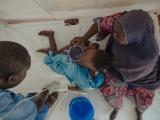The nation's annual report card for common foodborne infections shows that overall rates haven't changed significantly over the past 5 years, but Vibrio cases—while a minor contributor to the total—have been rising steadily, federal officials announced yesterday.
The report for 2013 shows that Salmonella cases were down 9% from the average for 2010-12, while Campylobacter infections were up 13% compared with the average for 2006-08. Vibrio infections—often linked to shellfish—in 2013 were 32% higher than in 2010-12 and 75% higher than in 2006-08.
But the overall picture stayed about the same. "Since 2006-08, the overall incidence has not changed significantly. More needs to be done," the Centers for Disease Control and Prevention (CDC) said in its report, published in today's Morbidity and Mortality Weekly Report (MMWR).
The numbers come from the CDC's FoodNet foodborne disease surveillance system, which covers 10 states with about 15% of the US population, roughly 48 million people.
A total of 19,056 infections, with 4,200 hospitalizations and 80 deaths, were reported to FoodNet in 2013, the CDC said. That compares with 19,531 cases, 4,563 hospitalizations, and 68 deaths reported a year ago in the data for 2012.
Besides those mentioned, the report covers the bacterial pathogens Listeria, shiga-toxin producing Escherichia coli (both O157 and non-O157), and Yersinia, and the parasites Cryptosporidium and Cyclospora.
As in the past, Salmonella was the leading cause of foodborne infections, accounting for 48% of cases, followed by Campylobacter at 35%, said Robert Tauxe, MD, MPH, deputy director of the CDC's Division of Foodborne, Waterborne, and Environmental Diseases, at a press teleconference yesterday. Vibrio infections were at 1.2%, the report shows.
Case rates for all of the pathogens remain above the "Healthy People 2020" targets set by the government. For example, Salmonella incidence in 2013 was 15.19 cases per 100,000 population, versus a target of 11.4. For Campylobacter the 2013 rate was 13.82 per 100,000, with a target of 8.5.
Tauxe said the 9% decline in salmonellosis from the 2010-12 average brings the incidence down to where it was in 2006-08, though it is still well above the 2020 target. He said one probable factor in the 2013 drop is that a major national outbreak of S Enteritidis linked to eggs pushed the incidence up in 2010.
Since then, the Food and Drug Administration's safety rules for shell eggs have taken effect across the industry, noted Stephen Ostroff, MD, the FDA's chief scientist. The rules require preventive measures in poultry houses and refrigeration of eggs during transportation.
USDA Salmonella standards
David Goldman, MD, MPH, of the US Department of Agriculture's (USDA's) Food Safety and Inspection Service (FSIS), commented at the press conference that although Salmonella detections in FSIS testing of chicken carcasses have dropped 75% since 2006, "this has not translated into lower infection rates."
The USDA tightened its performance standard for Salmonella on whole chickens in 2011, and in 2013, 3.9% of samples tested positive, the CDC report says. Because raw chicken is usually sold as parts, the USDA did a survey of chicken parts in 2012 and found that 24% of samples were contaminated with Salmonella.
Consequently, the USDA is now developing a performance standard for chicken parts, according to Goldman. "We hope to publish a proposal in the next few months," he said.
The CDC said that although the 2013 incidence of Campylobacter cases was 13% higher than in the 2006-08 period, it was about the same as the average for 2010-12.
The USDA is considering developing a performance standard for Campylobacter in poultry, but no decision has been made on whether to go forward, said Goldman.
He explained that the agency also looked at Campylobacter levels when it did the survey of Salmonella in chicken parts. "We're still in the process of developing all these standards and determining if the data will support a performance standard for Campylobacter," he said.
In response to questions, he added that if a pathogen is present at only very low levels, there may be regulatory or policy options other than a performance standard for controlling it.
Vibrio cases climbing
The CDC report shows that FoodNet picked up 242 Vibrio cases in 2013, for a rate of 0.51 per 100,000 population, with 55 hospitalizations and 2 deaths.
Tauxe said that rate represents a 168% increase since 1996-98, when FoodNet surveillance began. "For Vibrio it's been a pretty consistent increase" relative to all of the comparison periods the CDC is using (1996-98, 2006-08, and 2010-12), he said.
The report notes that Vibrio infections are more common in the summer, when the organisms are more abundant in seawater. About 50% of Vibrio infections are foodborne, typically from oysters, with most of the rest linked to contact with seawater.
While overall Vibrio cases have been rising, infections with V vulnificus, the most virulent species, have been steady, the CDC said. Meanwhile, another Vibrio species has been on the move: in 2012 and 2013, many infections with a V haemolyticus strain previously seen only in the Pacific Northwest were identified on the Atlantic Coast, in illnesses linked to oysters and other shellfish.
Concern about changes in testing
In other observations, Tauxe voiced concern that the growing use of "culture-independent diagnostic tests" (CIDTs) may impair the ability to track foodborne infections and outbreaks in coming years.
He said clinical labs are now using a rapid test for streptococcal infections, adding, "Now other new culture-independent tests are starting to be used by clinical labs for identifying other infections. These don't isolate a living germ that can be studied. For many years foodborne disease tracking has relied on those living cultures."
The CDC report says that in 2013 there were 1,487 reports of positive CIDTs that were not confirmed by a culture, either because the specimen was not cultured or a culture did not yield the pathogen. It adds that labs probably send only a low percentage of CIDT-positive specimens for confirmatory testing, because there are no national guidelines for confirmation of CIDT results.
Tauxe said FoodNet needs cultures of pathogens to confirm that "we're counting a real infection" and also to do DNA fingerprinting, which makes it possible to identify outbreaks.
CDC. Incidence and trends of infection with pathogens transmitted commonly through food—Foodborne Diseases Active Surveillance Network, 10 US sites, 2006-2013. MMWR 2014 Apr 18; 63(15):328-32 [Full text]
See also:
Apr 17 CDC press release
Related Apr 18, 2013, CIDRAP News story






















